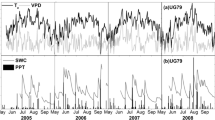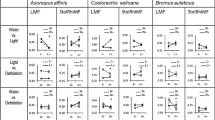Abstract
Exclosure cages are often used for estimating biomass accumulation on continuously stocked pastures in grazing experiments. The microclimate inside the cages may affect the estimates of biomass accumulation, but this has not been previously identified or quantified. We evaluated how the exclusion from grazing for 21 days in Mulato II brachiariagrass (Brachiaria brizantha × Brachiaria decumbens × Brachiaria ruziziensis) pastures affected canopy air temperature (T) and relative humidity (RH) and how this related to biomass accumulation. We also evaluated the effect of the exclosure cage on wind speed (WS) and incoming solar radiation (SR), and how these impacted evapotranspiration (ET) and estimates of biomass accumulation on grazed canopies maintained at 20- and 30-cm height under continuous stocking. Regardless of canopy height, changes in canopy structure during the exclusion period up to 21 days did not affect T and RH (averages of 24.3 °C and 88.7%, respectively), indicating that the air circulation was not affected by the exclusion. The cage structure reduced SR by 5%, although there were times during clear days when SR was slightly greater inside the cage than outside. The cage also reduced WS by 4.4%. Smaller SR and WS resulted in less ET inside the cages than outside, although with close values (2.9 vs. 3.0 mm day−1; P = 0.0494). The biomass accumulation rate was greater inside than outside the cages for both canopy heights. This overestimation would be 5.8 and 9.7% greater if the structure of the cage did not reduce the SR, WS, and ET.





Similar content being viewed by others
Data availability
The data supporting the findings of this study are available from the corresponding author, upon request.
References
Allen RG, Pereira LS, Raes D, Smith M (1998) Crop evapotranspiration - guidelines for computing crop water requirements - FAO irrigation and drainage paper 56. FAO, Roma
Allen VG, Batello C, Berretta EJ et al (2011) An international terminology for grazing lands and grazing animals. Grass Forage Sci 66:2–28. https://doi.org/10.1111/j.1365-2494.2010.00780.x
Alvares CA, Stape JL, Sentelhas PC et al (2013) Köppen’s climate classification map for Brazil. Meteorol Zeitschrift 22:711–728. https://doi.org/10.1127/0941-2948/2013/0507
Barker DJ, Ferraro FP, Nave RG et al (2010) Analysis of herbage mass and herbage accumulation rate using gompertz equations. Agron J 102:849–857. https://doi.org/10.2134/agronj2009.0381
Carnevalli RA, Silva SC, Carvalho CAB et al (2001) Pasture and animal responses of Coastcross swards grazed by sheep under continuous stocking. Pesqui Agropecuária Bras 36:919–927. https://doi.org/10.1590/S0103-90162001000100002
Carter JF (1962) Herbage sampling for yield: tame pastures. In: American Society Agronomy, American Dairy Science Association, American Society of Animal Production, American Society of Range Management (eds) Pasture and Range: research techniques. Comstock Publishing Associates, Ithaca, pp 90–101
Carvalho CAB, Silva SC, Sbrissia AF et al (2000) Tiller demography and dry matter accumulation rates in ‘Tifton 85’ swards under grazing. Sci Agric 57:591–600. https://doi.org/10.1590/S0100-204X2001000300023
Cosgrove D, Holbrook A (2013) Water balance of plants. In: Taiz E, Zeiger E (eds) Plant Physiology, 5th edn. Sinauer Associates, Sunderland, pp 85–105
Cowlishaw SJ (1951) The effect of sampling cages on the yields of herbage. Grass Forage Sci 6:179–182. https://doi.org/10.1111/j.1365-2494.1951.tb00926.x
Doi M, Kitagawa Y, Shimazaki KI (2015) Stomatal blue light response is present in early vascular plants. Plant Physiol 169:1205–1213. https://doi.org/10.1104/pp.15.00134
Eckardt NA (2012) Wavelength dependence of quantum yield for CO2 fixation and photochemical efficiencies of photosystems I and II. Plant Cell 24:1711. https://doi.org/10.1105/tpc.112.240512
Frame J (1981) Hebage Mass. In: Hodgson J, Baker RD, Davies A et al (eds) Sward Measurement Handbook. British Grassland Society, Berkshire, pp 39–70
Gautier H, Varlet-Grancher C, Hazard L (1999) Tillering responses to the light environment and to defoliation in populations of perennial ryegrass (Lolium perenne L.) selected for contrasting leaf length. Ann Bot 83:423–429. https://doi.org/10.1006/anbo.1998.0840
Heady HF (1957) Effect of cages on yield and composition in the California annual type. J Range Manag 10:175–177. https://doi.org/10.2307/3893815
Hodgson J (1990) Grazing management: science into practice. Longman Group & Techical, London
Kollist H, Nuhkat M, Roelfsema MRG (2014) Closing gaps: linking elements that control stomatal movement. New Phytol 203:44–62. https://doi.org/10.1111/nph.12832
Littell RC, Milliken GA, Stroup WW et al (2006) SAS for Mixed Models, 2nd edn. SAS Institute, Cary, NC
Mazzanti A, Lemaire G (1994) Effect of nitrogen fertilization on herbage production of tall fescue swards continuously grazed by sheep. 2. Consumption and efficiency of herbage utilization. Grass Forage Sci 49:352–359. https://doi.org/10.1111/j.1365-2494.1994.tb02010.x
Monteith JL, Ong CK, Corlett JE (1991) Microclimatic interactions in agroforestry systems. For Ecol Manage 45:31–44. https://doi.org/10.1016/0378-1127(91)90204-9
Morelli G, Ruberti I (2000) Update on light signaling shade avoidance responses. Driving auxin along lateral routes. Plant Physiol 122:621–626. https://doi.org/10.1104/pp.122.3.621
Parsons AJ, Collett B, Lewis J (1984) Changes in the structure and physiology of a perennial ryrgrass sward when released from a continuous stocking management: continously stocked swards. Grass Forage Sci 39:1–9. https://doi.org/10.1111/j.1365-2494.1984.tb01658.x
Pequeno DNL, Pedreira CGS, Boote KJ et al (2018) Species-genotypic parameters of the CROPGRO Perennial Forage Model: implications for comparison of three tropical pasture grasses. Grass Forage Sci 73:440–455. https://doi.org/10.1111/gfs.12329
Portela JN, Pedreira CGS, Braga GJ (2011) Demography and density of signalgrass tillers grazed under intermittent stock grazing. Pesqui Agropecuária Bras 46:315–332. https://doi.org/10.1590/S0100-204X2011000300013
Prendergast JJ, Brady JJ (1955) Improved movable cage for use in grassland research. Grass Forage Sci 10:189–190. https://doi.org/10.1111/j.1365-2494.1955.tb00022.x
Silva VJ, Pedreira CGS, Sollenberger LE et al (2016) Canopy height and nitrogen affect herbage accumulation, nutritive value, and grazing efficiency of ‘Mulato II’ brachiariagrass. Crop Sci 56:2054–2061. https://doi.org/10.2135/cropsci2015.12.0764
Thornthwaite CW, Mather JR (1955) The water balance. Drexel Institute of Technology – Laboratory of Climatology, Centerton
’t Mannetje L (1978) Measuring quantity of grassland vegetation. In: ’t Mannetje L (ed) Measurement of grassland vegetation and animal production. CAB International, Queensland, pp 63–95
’t Mannetje L (2000) Measuring biomass of grassland vegetation. In: ’t Mannetje L, Jones RM (eds) Field and laboratory methods for grassland and animal production research. CABI Publishing, Wallingford, pp 151–177
Wheeler JL, Burns JC, Mochrie R, Gross H (1973) The choice of fixed or variable stocking rates in grazing experiments. Exp Agric 9:289–302. https://doi.org/10.1017/S0014479700010085
Williams SS (1951) Microenvironment in relation to experimental techniques. Grass Forage Sci 6:207–217. https://doi.org/10.1111/j.1365-2494.1951.tb00931.x
Wolfinger R (1993) Covariance structure selection in general mixed models. Commun Stat - Simul Comput 22:1079–1106. https://doi.org/10.1080/03610919308813143
Yasuoka JI, Pedreira CGS, Holschuch SG et al (2021) The exclosure cage technique revisited: pasture responses under continuous stocking and their relationship with estimates of forage accumulation in grazing experiments. Crop Sci 61:1488–1499. https://doi.org/10.1002/csc2.20447
Acknowledgements
We thank Dr. F.A.P. Santos and Dr. M.A. Penatti for supplying the animals used in the experiment. We also thank Dr. C.Bosi for his help with modeling the growth of Mulato II brachiariagrass.
Funding
This study was supported by Coordination for the Improvement of Higher Education Personnel (CAPES, Finance Code 001) and by São Paulo Research Foundation (FAPESP; grant number 2017/11288–6) with a Doctoral Scholarship to the first author.
Author information
Authors and Affiliations
Contributions
J.I.Y., C.G.S.P., and P.C.S. designed the study; J.I.Y. analyzed the data and wrote the manuscript with contributions from C.G.S.P. and P.C.S.; J.I.Y., E.H., G.B.P., O.G.A., and S.G.H. conducted the experiments.
Corresponding author
Ethics declarations
Ethics approval
The study was approved by the local Committee on Ethics in Animal Use (Protocol N° 2016–24).
Consent to participate
Not applicable.
Consent for publication
Not applicable.
Conflict of interest
The authors declare no competing interests.
Rights and permissions
About this article
Cite this article
Yasuoka, J.I., Pedreira, C.G.S., Holcman, E. et al. Microclimate of grass canopies and biomass accumulation are influenced by the use of caged exclosures in grazing research. Int J Biometeorol 66, 45–54 (2022). https://doi.org/10.1007/s00484-021-02187-w
Received:
Revised:
Accepted:
Published:
Issue Date:
DOI: https://doi.org/10.1007/s00484-021-02187-w




